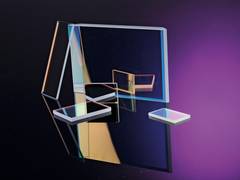Different Splitters and Applications
UK45-0010
Laser beams often have to be split into two or more partial beams, and not always in equal amounts. The following options are available:
Classic thin plate polarising (TFP) beam splitters are produced for a single wavelength and a specified polarisation. A partially reflecting dielectric coating is applied to a coplanar plate. The wavelength and polarisation are defined by the customer, for example, a reflection of 50% can be achieved for s-pol light at 1064nm and the remaining light is transmitted. The same beam splitter used with p-pol light would reflect a completely different amount of light, approximately 30%. For predictable results, the customer must make sure that the polarisation of the laser is constant and does not change during operation.
Polarisation independent beam splitters are used when the same reflection is required for both s-pol and p-pol polarisation states. The thin film coating is applied to the substrate using ion beam sputtering (IBS). As this is a time consuming process IBS coatings are generally more expensive, but is the only way to ensure deviations of less than 1% between p- and s-polarised light.
Variable beam splitters are required to achieve identical intensities at several operating stations, for example in a laser material processing factory. These beam splitters have an “area of adjustment” typically between 45% and 55%. Their reflectivity varies along the position of the substrate and so can be re-adjusted allowing the correction of deviations in the beam path.
Cubic beam splitters consist of two 45 degree prisms with one hypotenuse face coated with the beam splitter coating. The advantage of a CBS is that the optical beam is not ‘dog-legged’ like that observed in a thin plate beam splitter.
Diffractive optical element (DOE) beam splitter diffraction gratings that split incident light into two or more paths or varying light intensity. Fused silica DOEs offer high power laser beam handling.
For these or other more exotic beam splitters contact us with your requirements.
Datasheet:
Further product information:
Partially Reflective Coating
Manufacturer:
LASER COMPONENTS Germany / Laser Optics
Contact:
| Contact Person: | Chris Varney |
| Company: | LASER COMPONENTS (UK) Ltd. |
| Address: | Goldlay House 114 Parkway |
| Postcode / City: | CM2 7PR Chelmsford Essex |
| Phone: | +44 1245 491499 |
| Fax: | +44 1245 491801 |
| Email: | cvarney@lasercomponents.co.uk |
| |
|






















































